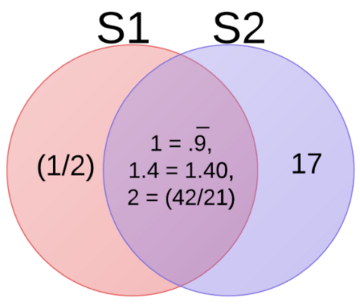| Line 23: | Line 23: | ||
=== Answer 1 === | === Answer 1 === | ||
| + | <span style="color:red">Instructor's note: This is really the second answer presented. It would be better if we could keep the first answer "as is", and put the correction as a second answer. Mistakes are nothing to be ashamed of! Making mistakes makes you learn! -pm</span> | ||
| + | |||
| + | |||
All elements in the following union are distinct, therefore the union is a set. | All elements in the following union are distinct, therefore the union is a set. | ||
| Line 29: | Line 32: | ||
[[Image:Lecture_3.PNG| 360x360px]] (<math class="inline"> S_1 \cup S_2</math> represented by colored region.) | [[Image:Lecture_3.PNG| 360x360px]] (<math class="inline"> S_1 \cup S_2</math> represented by colored region.) | ||
| − | :<span style="color:green">WOW! That's a VERY nicely written answer. Great work. You only missed one little (somewhat tricky) detail. Can you guess what it is? MATH MAJORS: Can you help him? </span> | + | :<span style="color:green">WOW! That's a VERY nicely written answer. Great work. You only missed one little (somewhat tricky) detail. Can you guess what it is? MATH MAJORS: Can you help him? -pm</span> |
:Okay, answer above edited to account for the following: | :Okay, answer above edited to account for the following: | ||
| Line 36: | Line 39: | ||
:<math class="inline">\frac{1}{9} * 9 = 1</math> | :<math class="inline">\frac{1}{9} * 9 = 1</math> | ||
:<math>\therefore 0.\bar{9} = 1</math> | :<math>\therefore 0.\bar{9} = 1</math> | ||
| + | :<span style="color:green">Instructor's comment: There you go! -pm</span> | ||
---- | ---- | ||
=== Answer 2 === | === Answer 2 === | ||
Revision as of 07:26, 12 January 2013
Contents
Practice Problemon set operations
Consider the following sets:
$ \begin{align} S_1 &= \left\{ \frac{1}{2}, 1, 1.4, 2 \right\}, \\ S_2 & = \left\{ 0.\bar{9}, 1.40, \frac{42}{21}, 17\right\}. \\ \end{align} $
Write $ S_1 \cup S_2 $ explicitely. Is $ S_1 \cup S_2 $ a set?
You will receive feedback from your instructor and TA directly on this page. Other students are welcome to comment/discuss/point out mistakes/ask questions too!
Answer 1
Instructor's note: This is really the second answer presented. It would be better if we could keep the first answer "as is", and put the correction as a second answer. Mistakes are nothing to be ashamed of! Making mistakes makes you learn! -pm
All elements in the following union are distinct, therefore the union is a set.
$ S_1 \cup S_2 = \{ \frac{1}{2}, 1, 1.4, 2, 17 \} $

- WOW! That's a VERY nicely written answer. Great work. You only missed one little (somewhat tricky) detail. Can you guess what it is? MATH MAJORS: Can you help him? -pm
- Okay, answer above edited to account for the following:
- $ \frac{1}{9} = 0.\bar{1} $
- $ \frac{1}{9} * 9 = 0.\bar{9} $
- $ \frac{1}{9} * 9 = 1 $
- $ \therefore 0.\bar{9} = 1 $
- Instructor's comment: There you go! -pm
Answer 2
The union of S1 and S2 is all the elements in the Venn diagram: in S1, S2, and in both S1 and S2.
Answer 3
Write it here.

